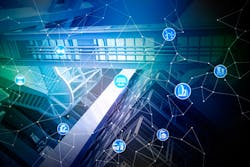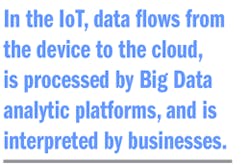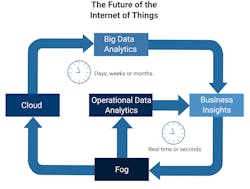In the human body, the nervous system collects continuous streams of sensory data and transmits the information to the brain to be processed. It helps coordinate actions throughout the body, efficiently collecting data about the environment and simultaneously driving actions. If software is the brain of the IoT, sensors are the nervous system. There is no questions the Internet of Things (IoT) is currently a hot topic across industries. Although there is much discussion about solutions leveraging the IoT, it is still largely underutilized. There are numerous obstacles to overcome before organizations can fully reap the rewards of successful IoT deployments. The focus of IoT conversations have been on Big Data, analytics, and cloud computing, but as much as the IoT is about software, it is equally about sensors. This article offers a framework for understanding the Internet of Things and discusses the path forward in order to achieve its full potential.
Clarifying IoT Terms
Before moving forward, it is beneficial to clarify the term IoT in the context of this article. In conversations about the IoT there is typically a distinction between the Internet of Things (IoT) for consumer products and the Internet of Things for industry. The latter is generally differentiated with the designation of the Industrial Internet of Things (IIoT). Although distinguishing between the IIoT and the IoT has its merits, they are really all part of the same Internet of Things. Industrial and commercial applications are further ahead in developing IoT solutions that provide real value, while consumer IoT products and applications have only demonstrated moderate value at best. There are exceptions of course, but generally speaking, consumer applications of the IoT currently provide nice to have solutions rather than need to have results. Despite having plenty of room to develop and grow, commercial applications of the IoT have demonstrated real business value. This article will refer to the IoT as one large category while focusing on commercial applications.
Beneath the cloud layer is the fog: an equally important but less frequently discussed component to the IoT. The fog consists of the devices themselves, sensors, fog computing, and connectivity while the cloud includes the global infrastructure and data storage, analytics is the analysis of the data and business insight includes the interpretation of data. The business insight then drives business value through the development of custom applications, changes in business processes, adjusting device deployment, and more. The entire process from the time data is acquired until an organization can implement the insights can take days, weeks or months to accomplish. This is partially a result of relying on Big Data to deliver insights.
The Data Path and Moving Forward
A fog computing solution involves real time, or near real time feedback and performance adjustment. To use an example from a similar environment to the above, an aircraft wing could be instrumented with a sensing platform that monitors the shape and load distribution of the wing in real time. That data could be fed into a flight control feedback loop so the aircraft can adjust the shape of the wing in real time in order to optimize aerodynamics and thus reduce fuel consumption. Such an application is being investigated by NASA Armstrong and the United States Air Force with the Adaptive Compliant Trailing Edge project. Another example of the power of quick insights is the implementation of a structural health monitoring system on a bridge. Critical load bearing supports on a bridge can be instrumented with sensors and monitored periodically or continuously. The monitoring system could track the integrity of the supports to detect any damage or changes. If, for example, a crack begins to form, the system could alert the organization responsible for maintaining the infrastructure and a decision could be made as to how to proceed. These types of applications are what will accelerate the adoption of IoT solutions because it addresses immediate business needs.
Right now the focus of IoT conversations is around cloud computing and Big Data. The type of insights provided by the cloud typically answer why a device behaved a certain way by looking at data over long periods of time. The lower layer, fog computing, generally tells “what” a device is doing. The full realization of the IoT depends on both cloud computing and fog computing, but the latter will be the ultimate driving force for adoption. Organizations today require real time insights into their products, applications and services. As a result, the industry will see a shift in development efforts down to the fog layer.
Innovation in the fog
In order for the IoT to drive toward operational data, significant advances to the fog layer need to occur. As described above, the fog layer consists of sensors, signal processing and network connectivity. Each element of the fog faces different challenges, but they are all interrelated. For example, there are sensors available today are capable of obtaining spatially continuous data over hundreds of meters in real time, but wireless connectivity solutions can restrict the amount of data that is transmitted. As a result, sensor innovation also requires connectivity advances. Sensors are often overlooked in discussions about the IoT except from being mentioned in passing. They are, however, one of the most critical elements in IoT applications since they are the component that makes devices smart. If computing is the brains of the IoT, then sensors are the nervous system continuously collecting and transmitting data about a device, machine, structure or process. Without advancing the nervous system of the IoT, the brain will have a limited impact.
Some, like The Technology Partnership, argue that the IoT is really the Internet of Sensors. They argue that the IoT is a solution looking for a problem, whereas taking a sensors focused approach allows businesses to resolve a problem with a solution. Since there is a large amount of data that isn’t being listened to, businesses can actively pursue ways to capture that information with sensors and implement new solutions that provide actual operational value. For example, as stated by The Technology Partnership, heavy industry could save billions by reducing energy consumption with better temperature modeling. The only way to accomplish this is by instrumenting devices with sensors, however, sensors in their current form may not always be able to accomplish the monitoring goals of organizations.
When talking about sensors, most people refer to point sensors based on electronic principles where each sensor collects a single point of information. This form has largely been the only type of sensor available for decades, but demands on sensors have grown over the years and will continue to do so in the future. The drawback to point sensors is that engineers and businesses only get a handful of snapshots of how their device, machine or structure is behaving. Returning to the heavy industry example, point temperature sensors can monitor critical areas on a piece of machinery, but are not able to provide information about important spaces between these critical areas. For an accurate temperature model, it is essential to know how temperature is distributed throughout a structure. Point sensors are not able to provide data about a full temperature distribution. In essence, using point sensors is like having only tens of pixels to determine what an image in a photograph looks like. As a result, sensor innovation is required to help meet the demands of the IoT.
There are technologies available today that can obtain spatially continuous data. For example, digital image correlation, which is primarily used in a laboratory setting, can observe both strain fields and displacement of an object. Similarly, thermography can determine the thermal profile of a structure or object. These technologies may not be suitable for many IoT applications because they require line of sight and can be cumbersome to deploy in the field. Another technology that can obtain spatially continuous data is fiber optic sensing. Some fiber optic sensing systems can collect spatially continuous strain and temperature data along the entire length of the fiber in real time. This technology is a good fit for IoT applications that require a large number sensors to be monitored for validating models, ensuring structural integrity, and testing new materials. Although not every IoT application currently requires this level of sensor density, the variety of applications that benefit form spatially continuous data will continue to increase over time. This will both drive and be driven by organizations deploying IoT solutions that shift from Big Data solutions to operational data.
The Internet of Things has the potential to explode into a massive market, but faces many challenges to reaching full realization. In order for adoption of the IoT across industries to take root the market will shift from Big Data analytics solutions to operational data. Sensor innovation is critical to driving this change. Businesses that invest in these technologies now will reap the benefits of being first to market as the IoT fully develops.
About the Author
Michael Heflin
Michael has been leading companies and inspiring teams for over 20 years. Specializing in identifying, growing, and increasing value in emerging technology markets, he has held executive roles at companies like Vantive, ADP, Fracta, Convergys, and Whisperwire. Before joining Sensuron, Michael guided four companies to lead their industry in sales, including two publically traded companies with valuations worth $2 billion. He has experience navigating domestic and international companies through successful acquisitions. Passionate about forming and counseling value-driven teams, he has a history of successfully guiding and inspiring teams worldwide.




